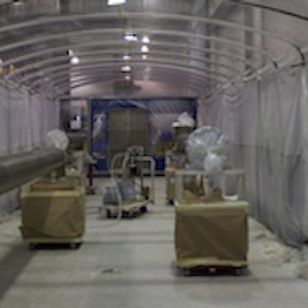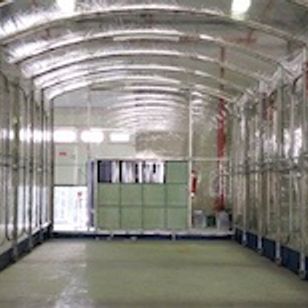How to Determine if Retractable Enclosures Are Industrial Grade
Retractable enclosures are not “one size fits all.” The applications they are used for — from consumer-grade pool covers to industrial-grade oversized clean rooms — are simply too diverse.
There’s no reason, for example, why retractable enclosures that are used to protect cargo on trailer beds should meet NFPA standards.
On the other hand, if you’re in the market for an industrial-grade retractable enclosure system, you’ll want to make sure that the product your considering meets all the requisite safety and EHS standards, as well as functions as an effective piece of equipment for your operation.
Unfortunately, the information and specifications often needed to determine if a retractable enclosure is industrial grade are not always readily available. Here, then, are some areas for you to keep in mind — and to ask about when you are trying to source industrial retractable enclosures.
Engineering
Industrial-grade retractable enclosures need to be designed to work in industrial environments. The engineers behind them have to understand use cases and account for them up front.
Examples of design features that make a big difference when it comes to retractable enclosures designed for industrial environments include:
- Welded construction – This avoids joints that can lead to premature wear and tear of an enclosure’s covering material. It also makes a retractable enclosure much more solid. Nuts and bolts tend to get loose, making enclosures wobbly and causing air gaps.
- *Industrial-grade casters (No. 4) – *You’d never expect a transfer cart with anything less than heavy-duty casters to stand up in an industrial environment. Same goes for retractable enclosures, which depend on their ability to roll along the shop floor to open and close.
Materials
You don’t have to tell anyone who works in manufacturing that the type of material something is made out of makes a big difference.
The two materials that count the most for retractable enclosures are the metal the frame is made of and the vinyl used to form the enclosure’s “tent.”
- *Steel — *It’s not just a matter of having a steel frame (vs. an aluminum frame) but whether that frame is made out of robust tube stock. Anything formed from sheet or using tube steel with less than a 0.083-inch-thick wall will not hold up for very long in an industrial workspace.
- Vinyl — The tents for industrial retractable enclosures need to be made out of industrial-grade NFPA 701–compliant vinyl. Using heavy-duty vinyl — at least 16-mil. — that is fire-safety rate will ensure that the material will not catch a spark. Another thing to consider is whether or not the vinyl is see-through—an important feature if your process requires light transfer or depends on ambient light for visibility in the enclosed workspace.
Code Compliance
Beyond just NFPA compliance, there are a host of other EHS requirements that your provider of industrial retractable enclosures should be able to address with their products — depending on your location, industry, and processes.
These regulations include:
UL
Standards to measure and validate performance, environmental health and sustainability
NFPA 33
Standard Spray Application using flammable or combustible materials
NFPA 17
Standard for dry chemical extinguishing systems
NFPA 701
Standard methods of fire tests for flame propagation of textiles and films
OHSA O.Reg 851 – 63
Industrial establishments – Ignition or Explosive
OHSA O.Reg 851 -65
Dust – Ignition or Explosive
OHSA O.Reg 213
Construction Projects (5.12 Fire Code – Spray Operation)
OSHA 29CFR – 1910.107
Spray Finishing using flammable and combustible material
OSHA 29CFR – 1910.94
Ventilation
EPA 40CFR – Part 63.11173
Spray Finishing Requirements
Related Equipment
In an industrial setting, retractable enclosures will never be deployed in isolation. They need to be compatible with the equipment they will be used in conjunction with (e.g., material handling equipment) and often have to work directly with air quality control equipment such as dust collectors.
A manufacturer of industrial-grade retractable enclosures will understand this and will be able to evaluate the overarching business and production needs of an industrial setting — and speak to end-to-end solutions that extend beyond just retractable enclosures.
Finding Retractable Enclosures That Improve Your Industrial Business
The right supplier of retractable enclosures should be able to discuss their products as you would any other piece of industrial equipment. The conversation can tend toward the technical but should also speak to the projected ROI of the purchase.
Ultimately, acquiring a retractable enclosure is a capital expense that needs to make business sense — whether because it enhances your operation’s productivity, reduces material handlings costs, or protects you from non-compliance fines.
To learn more about how Duroair’s retractable enclosures can improve your operation and affect your bottom line, request a consultation with a Duroair clean air expert today.

